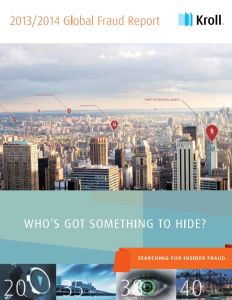
Kroll and Economist Intelligence Unit
Who’s Got Something to Hide?
Searching for Insider Fraud
Kroll, 2014
What's inside?
Corporate fraud is growing around the world. Is your company ready for the task of controlling it?
Recommendation
Increased globalization and technological innovation have multiplied opportunities for crime in areas such as information theft, procurement and management conflict of interest. While some firms have enhanced efforts to detect malfeasance, others have done little to stem what threatens to become a powerful tide. In its international survey of 901 corporate executives, risk management firm Kroll – assisted by the Economist Intelligence Unit – does an admirable job of assessing corporate fraud and its future prospects. getAbstract recommends this comprehensive report to senior executives, risk managers and others responsible for detecting and combating corporate fraud.
Take-Aways
- In a 2013 survey, 70% of companies reported experiencing at least one instance of fraud, up from 61% the prior year. Average fraud costs rose from 0.9% of revenue in 2012 to 1.4% in 2013.
- Information theft occurred in more than 20% of companies, yet almost one-third of firms report no IT security expenditures, and many lack a cohesive response plan.
- At the heart of most fraud is a “careless, vengeful or malicious employee” or contractor. Other employees are a firm’s best defense: Whistle-blowers’ warnings helped in revealing 41% of fraud cases involving middle and senior managers.
- Less than 70% – which is the global average – of firms in the United States, Mexico and Colombia reported fraud in 2013. Sub-Saharan Africa and Russia vie for the highest prevalence of fraud in the world.
- Companies should devote more time and energy to fortifying their risk management and due diligence. Senior managers must lead such efforts by laying the groundwork for ethical behavior.
Summary
Corporate fraud is increasing: In a 2013 survey, 70% of global executives report that their companies experienced at least one criminal incident that year, up from 61% in 2012. Average fraud costs rose from 0.9% of revenue in 2012 to 1.4% in 2013, and cases of “vendor, supplier or procurement fraud and management conflict of interest” grew the most. Respondents view fraud as more of a threat now than in the past, and many admit that their firms are vulnerable in areas such as the theft of assets, information and intellectual property. Globalization raises the stakes: Some 54% say that outsourcing, offshore businesses and/or joint partnerships have increased their exposure, and the perception of fraud and corruption overseas prevents some firms from investing in regions with poor reputations.
“Following a decrease in 2012, fraud is on the rise again, and so are the costs involved in managing it.”
Information theft – second only to asset theft as the most common fraud in 2013 – occurred in 22% of companies. Yet almost one-third of firms report no IT security expenditures, and 50% lack a cohesive response plan. While outsiders, particularly external hackers, are increasingly to blame, a “careless, vengeful or malicious employee” or contractor is most often responsible. Other workers are a firm’s best defense: Whistle-blowers’ warnings helped in revealing 41% of fraud cases involving middle and senior managers. Firms should be aware of the risks in making proprietary information available to temporary foreign workers, contractors and remote employees.
“The move to a more global business model that relies on a network of suppliers and partners is leading to a higher risk of fraud.”
Fraud assumes different characteristics around the world. Less than 70% (the global average) of firms in the United States, Mexico and Colombia reported 2013 frauds; management conflict of interest mostly plagues the US, while theft of physical assets afflicts Mexico and Colombia. A full 73% of European companies experienced malfeasance, including property theft (28%) and internal financial fraud (17%). Sub-Saharan Africa and Russia vie for the highest prevalence of fraud in the world: In the former, almost half arises from physical property theft, while corruption affects nearly one-third of Russian firms.
“Awareness of fraud is up, regardless of whether it’s related to cybercrime, information theft, outsourcing or expansion into new and riskier markets. Yet measures to guard against fraud continue to be constrained by budgets and corporate policy.”
Companies should devote more time and energy to risk management and due diligence. Senior managers must lead such efforts by laying the groundwork for ethical behavior.
About the Authors
Kroll is a global provider of risk management solutions. The Economist Intelligence Unit is an independent research and analysis organization.
This document is restricted to personal use only.
My Highlights
Did you like this summary?
Get the ReportThis summary has been shared with you by getAbstract.
We find, rate and summarize relevant knowledge to help people make better decisions in business and in their private lives.
Already a customer? Log in here.































Comment on this summary